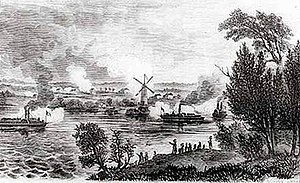Hunter Patriots
| Patriot War | |||||||||
|---|---|---|---|---|---|---|---|---|---|
 Battle of the Windmill |
|||||||||
|
|||||||||
| Belligerents | |||||||||
|
|
Hunters' Lodges Republic of Canada |
||||||||
| Commanders and leaders | |||||||||
|
George Browne Henry Dundas James FitzGibbon Allan MacNab Sheriff William Jarvis |
Robert Nelson Cyrille-Hector-Octave Côté William Lyon Mackenzie Charles Duncombe Donald McLeod Nils von Schoultz Samuel Lount |
||||||||
The Hunters' Lodge was the last of a series of secret organizations formed in 1838 in the United States in the Rebellions in the Canadas. The organization arose in Vermont among Lower Canadian refugees (the eastern division or Frères chasseurs) and spread westward under the influence of Dr Charles Duncombe and Donald McLeod, leaders of the short lived Canadian Refugee Relief Association, and Scotland native William Lyon Mackenzie, drawing in support from many different areas in North America and Europe. They also absorbed Henry S. Handy's 'Secret Order of the Sons of Liberty' in Detroit, into a Grand lodge in Cleveland.
The Hunters Lodges were modelled on masonic lodges, and adopted similar secret signs, hierarchical orders, and rituals. The four degrees of the Lodge were: Snowshoe, Beaver, Grand Hunter and Patriot Hunter. Soldiers without rank were of the first degree, commissioned officers of the second, field officers of the third, and the highest ranking commissioned officers of the fourth degree.
They also utilized a secret code, sometimes printed in newspapers like the Buffalonian, to communicate orders.
Lodges existed across Vermont, western New York, Ohio and Michigan with particularly active sites being Watertown, Oswego, Salina (now Syracuse), Rochester, Buffalo, Cleveland, and Detroit.
In September 1838, 70 delegates from the western Hunters' Lodges attended a secret, week-long “Patriot Congress” in Cleveland, Ohio. They appointed a provisional Canadian republican government that included:
To fund the war, they formed a joint stock bank, the Republican Bank of Canada, with Secretary of the Treasury John Grant, Jr. as President. They printed bills with pictures of Rebellion martyrs Samuel Lount and James Morreau on them. The official newspaper of the organization was the Bald Eagle published in Cleveland by Samuel Underhill.
The leadership of the Patriot movement appears to have belonged to the small Equal Rights Party (known more popularly as the Locofocos). The small party emerged in 1836 in New York with a platform emphasizing radical republicanism, an end to the "moneyed aristocracy", and "Free Banking". The Republican Bank of Canada was formed on this basis. Dr Charles Duncombe was the author of Duncombe’s free banking: an essay on banking, currency, finance, exchanges, and political economy (Cleveland, Ohio, 1841); and Memorial to Congress upon the subject of Republican free banking (Cleveland, Ohio, 1841).
...
Wikipedia
